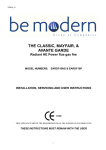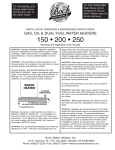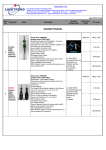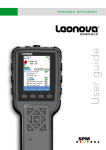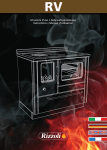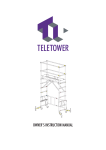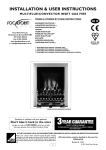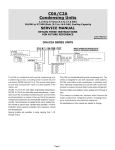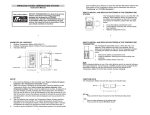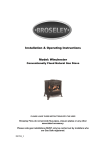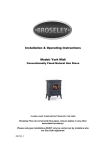Download the pureglow multiflue radiant gas fire
Transcript
THE PUREGLOW MULTIFLUE RADIANT GAS FIRE MODEL NUMBERS: EAR16NG & EAR16P Manual & Remote Control Models INSTALLATION, USER AND SERVICING INSTRUCTIONS THESE INSTRUCTIONS MUST REMAIN WITH THE USER 0120 THIS APPLIANCE MEETS THE REQUIREMENTS OF THE EUROPEAN GAS DIRECTIVE June 2005 (C)EAR16 Issue 5 Contents Page No. List of components 3 Appliance Data 3 GENERAL INSTALLATION REQUIREMENTS 3 Fitting the Appliance 3 Fitting the firebox and installing the burner unit 5 Additional notes for handset remote models 6 Fitting the optional spacer frame 6 Laying of ceramics & coals 6 Laying of ceramics, coals & pebbles 7 8 COMMISSIONING Lighting the appliance 8 Check for spillage 8 Briefing the User 8 9 USERS GUIDE Useful tips & recommendations 9 Operation of your fire 9 Manual Appliances 10 Handset remote models 10 Cleaning your fire 13 Assembling the fire and laying the coals 13 13 SERVICING & MAINTENANCE Spares Parts list 14 Installation & Service Record 15 Guarantee 16 Important Notes – Please read before undertaking the installation 1. This is not a “Do it yourself” product and it must be installed by a competent person. 2. The chimney must be swept before the appliance is fitted. 3. The Installation Instructions must be adhered to without exception. 2 Before fitting this appliance, ensure that the following components are enclosed (a) Pureglow Radiant (complete with burner) (b) Ceramic components. 1 Base 1 Rear (c) Coal pack comprising; 5 large, 5 medium, 23 random coals, or (d) Pebble pack comprising 5 Large Coals, 5 Medium Coals, 12 Large and 3 Small Pebbles. (e) Installation, User & Servicing Instructions (f) Trim (to order) and 4 magnets (g) Roll of sealing tape (h) Wire fixing kit c/w with instructions for use. (i) For Handset Remote Models only 1 Handset Control unit c/w 9V alkaline battery 1 Signal Receiver / Battery Holder 4 x 1.5 volt AA size alkaline batteries APPLIANCE DATA EAR16NG Gas Type Supply Pressure (mb) Heat Input (Gross) (kW) Injector Size (mm) Gas Connection Weight (kg) EAR16P Natural Gas Propane 20 37 6.7 6.7 1.90 1.3 8mm Compression 16.0 GENERAL INSTALLATION REQUIREMENTS Fitting the Appliance 1 The law demands that all gas appliances are installed by a qualified installer in accordance with the current Gas Safety (Installation and Use) Regulations. The installation must comply with these installation instructions and all relevant parts of Local and National Building Regulations or Building Standards (Scotland) (Consolidation) Regulations and those relevant recommendations of the following British Standards. BS 5871: Part 2. BS 8303. BS 5440: Parts 1 and 2. BS 1251. BS 6891 2 The appliance can be fitted to fire places which meet the dimensional requirements shown in figure 1. When fitting to a pre-cast gas flue-block, a minimum dimension of 10mm from the rear of the firebox to the front of the starter block must be provided. NOTE: BS5871: Part 2: requires a minimum debris collection space of 2 – 12 dm3 depending upon the type of flue. A maximum distance of 50mm must be maintained between the flue spigot and the back wall of the opening. 3 Decorative frets should have a minimum of 50cm2 (8sq.ins.) of free air space through the ash cover to ensure adequate air supply for both convection air and burner combustion. 3 FIGURE 1 4 THE HEARTH The appliance must be fitted with a non-combustible hearth having a minimum thickness of 12mm (1/2”). The hearth must be at least 300mm (12”) deep and must extend a minimum of 150mm (6”) either side of any naked flame or incandescent radiant source. The periphery of the hearth must be at least 50mm (2”) above floor level (under BS 5871 : Part 2, the installation of a fender of 50mm (2”) high will satisfy this requirement). HOLE IN THE WALL INSTALLATIONS. We recommend that a hearth is installed as detailed above, however if a hearth is not fitted the fire must be installed so that the distance from the base of the fireplace opening to the finished floor level is not less than 125mm. 5 THE CHIMNEY FLUE This appliance can be used with the following types of chimney or flue. (a) A conventional open flue of 7” or above (175mm). (b) A 5” diameter gas flue. (c) A gas flue- block system to BS 1289: Parts 1 & 2. NOTE: On certain flue block systems a spacer frame may be required. These are supplied separately; instructions for fitting the frame are given on Page 6 of these instructions. IMPORTANT The LPG version is not suitable for Gas Flue Block Systems. 6 7 8 The flue must have a minimum effective height of 3 metres. No restrictor plate or flue damper is permitted. Where a variable damper is fitted, this must be removed or locked in the open position. VENTILATION – Subject to satisfactorily completing a spillage test, these models do not require any additional purpose made ventilation. (England, Scotland & Wales only) 4 Fitting the firebox and installing the burner unit In addition to these instructions, if the wire fixing kit is to be used the fitter should be aware of the instructions that are inserted with the Wire fixing kit.) 1 Check that the firebox is of the correct size for the installation into the fireplace or recess. 2 It is recommended that, before proceeding further, a simple smoke test be performed to check the condition of the chimney. Light a smoke match or a twist of rolled paper, hold it within the fireplace opening and observe the behaviour of the smoke. If it is being drawn into the chimney proceed with the installation. If not, preheat the chimney over the period of a few minutes and recheck. If there is any doubt about the soundness of the chimney a smoke pellet should be used after preheating the flue and if smoke still fails to clear, further investigation of the chimney is required and the appliance MUST NOT be fitted. 3 The firebox can be installed with the fireback removed or left in situ provided that the requirements for debris collection area are met. (See Para 2, Page 3) 4 Clear the recess of any loose material. Ensure that the base on which the firebox will stand is level and that the base of the recess and the hearth are horizontal and noncombustible. 5 Slide the firebox into the opening, ensuring that the flue outlet is unobstructed and there is clear passage for the products of combustion to the flue. (Do not seal at this stage.) 6 The firebox should be fitted in such a manner as to be removable for the purpose of chimney sweeping and easy removal of debris. 7 The gas supply should be routed from the meter or cylinder to a point convenient to the fireplace. 8 The gas supply should be routed through the rear of the firebox. A knock out is provided in the rear of the box. Having determined the position of the gas pipe the knock out can be removed by a sharp tap with a hammer. Provision will have to be made to pass the pipe through the masonry of the fireplace. The gas supply should be run to make removal for servicing easy. 9 Cut and form a section of 8mm pipe, only rigid and semi–rigid tube is acceptable and run this into the fireplace opening. If a concealed fitting is required, care must be taken to sleeve the supply pipe when passing through the masonry. Exposed pipe within the fire opening should be wrapped, painted with bituminous paint or be factory sheathed. 10 Seal the firebox into the fire opening using the sealing tape provided or water based mastic. 11 Before the burner unit is fitted, check that the ignition system on the burner unit functions correctly. Push and return the control knob and check that a spark is generated at the pilot burner. If no spark is evident, check the soundness of the HT lead and also the spark gap distance between the electrode and the thermocouple tip. This distance should be approx. 4 mm 12 Check tightness of the nut at the control valve end of the thermocouple. CAUTION; do not over tighten. 13 Fit the burner unit into place within the firebox and screw in place with a single screw in the bottom of the control panel. (Touch Control and Handset Remote Control models; unscrew the battery box heat shield from the fascia to allow room to connect the gas supply. Ensure the gas supply pipe is horizontal where it meets the inlet fitting to make sure that there is room to re-fit the battery box heat shield. See Figure 2) 14 Prior to connecting the gas supply to the burner, the supply pipe must be purged to clear any debris that may be present which could cause a blockage or restriction in the control valve or pilot. 15 Using the nut and olive provided, connect the 8mm supply pipe to the combined pressure test point and isolator fitting. 5 16 When routing the gas supply pipe to the burner unit, soldered fittings must not be used under the burner tray. 17 GAS TIGHTNESS CHECK – Once the gas supply is connected, all joints must be checked for gas soundness in accordance with BS 6891. Note: It is permissible to light the fire FOR SHORT PERIODS ONLY when the fire is not laid with ceramics or coals. 18 Fit the outer trim into the position on the frame of the firebox using the four magnets provided. Where a brass or chrome trim is being used, ensure that the protective plastic coating is removed before the trim is fitted. Additional notes for Handset Remote Control Models 1. The installation of the appliance should be carried out as above. 2. After installing the burner and connecting the gas supply the battery heat shield must be re-fitted to the side of the fascia with the two self tapping screws provided. FIGURE 2 Fitting the optional spacer frame 1 Position the spacer frame behind the frame of the firebox such that the holes in the frame and firebox are lined up. 2 Screw the frame to the firebox using the 9 self tapping screws supplied. 3 Fit the firebox as described on page 5. Laying of ceramics & coals (See Page 7 for Pebble lay) WARNING This product uses fuel effect pieces containing Refractory Ceramic Fibre (RCF), which are man-made vitreous silicate fibres along with fibrous glass and mineral wool. Excessive exposure to these materials may cause temporary irritation to eyes, skin and respiratory tract, consequently, it makes sense to take care when handling these articles to ensure that the release of dust is kept to a minimum. CAUTION All the ceramic components are fragile and should be handled with care. 1 The burner tray and ceramics are illustrated in Figure 3. Take the base ceramic and place it on the burner. Then take the rear ceramic and place it at the rear of the firebox. It should rest on top of the base ceramic and against the rear wall of the firebox. 2 With reference to Figure 4, lay the coals as follows: ROW A Place the five large coals across the centre ceramic keeping them between the ridges. The coals should be positioned so they are equally spaced. 6 FIGURE 3 ROW B ROW C ROW D ROW E ROW F Place five medium coals directly FIGURE 4 on top of the five large coals and resting on the upper rear ceramic. Place seven random coals along the top of the front slotted ceramic. The coals should be positioned so they are touching and that they do not overhang the rear of the slotted area. Place a row of six random coals between the seven front coals and the five large coals. Place a row of five random coals along the back of the firebox resting half on the upper rear ceramic and half on Row B. The two outer coals should be pushed well into the corners of the firebox. Place another row of five random coals directly in the front of Row E resting partly on Row B and partly Row D. Laying of ceramics, coals & pebbles WARNING This product uses fuel effect pieces containing Refractory Ceramic Fibre (RCF), which are man-made vitreous silicate fibres along with fibrous glass and mineral wool. Excessive exposure to these materials may cause temporary irritation to eyes, skin and respiratory tract, consequently, it makes sense to take care when handling these articles to ensure that the release of dust is kept to a minimum. CAUTION All the ceramic components are fragile and should be handled with care. 1. The burner tray and ceramics are illustrated in Figure 3. Take the base ceramic and place it on the burner. Then take the rear ceramic and place it at the rear of the firebox. It should rest on top of the base ceramic and against the rear wall of the firebox. 2. With Reference to Figure 5, Lay the coals and pebbles as follows:ROW A. Place a row of five large coals, spaced approximately 5mm apart, across the middle of the base ceramic in the marked zone. ROW B. Place a row of five medium coals so that they rest on top of the coals of ROW A and rest firmly against the rear ceramic. ROW C. Place five large pebbles along the top of the raised slotted part of the base ceramic at the front of the burner. These pebbles should be positioned so that they are touching. ROW D. Place a row of four large pebbles between the five front pebbles and the five large coals. FIGURE 5 7 ROW E. Place a row of three large pebbles along the top of the rear ceramic. Fill the gaps along this row with three small pebbles. Please Note. Depending on how the pebbles actually lay in the fire some flames may impinge on the surface of some pebbles and cause soot marking. This is quite normal and the soot may be cleaned off when the fire is cold (see Servicing section) but unfortunately a permanent stain may be left on the surface. This problem can be minimised by gently twisting some pebbles with tongs to move them away from the tips of the flames which is where the soot marking may occur. COMMISSIONING When commissioning your Portway appliance, remove the cap from the isolator fitting and unscrew the plug all the way out. Replace the cap making sure that the tab engages with the slot in the top of the plug. Tighten cap securely. Light the appliance in accordance with the instructions relevant to the appropriate control. (See following sections for details) Lighting the appliance Full details on how to operate each of the appliances can be found as follows ¾ Manual Appliances Page 10 ¾ Remote Appliances Page 10 Check for spillage 1 Before briefing the customer on how to use the appliance, a spillage test must be carried out with the appliance and decorative fret in position. The following procedure must be followed. 2 Close all doors and windows in the room or space containing the appliance. 3 Light a smoke match and pass completely along the front edge (and just inside the top edge) of the firebox. A visual check should ascertain that all the smoke generated is drawn back into the firebox. 4 If there is evidence of spillage, the flue should be heated for a period of 5 to 10 minutes and the test repeated. Briefing the User 1 Demonstrate the full operation of the appliance to the customer, referring them specifically to the lay of the coals and the removal of soot, as described in these instructions. 2 Inform the customer that all cleaning procedures should be carried out only when the appliance is cold. 3 Leave these instructions with the customer. 4 Advise the importance of having the appliance serviced and the chimney checked for clearance of combustion products on an annual basis. 8 USERS GUIDE Useful tips & recommendations Once your fire has been fitted, the following recommendations are made to ensure you enjoy the best results from your purchase; 1 The installation of this appliance must be carried out by a qualified installer and in accordance with the requirements of the Gas Safety (Installation & Use) Regulations 2 The chimney must be swept before the appliance is installed and checked annually to ensure continued clearance of combustion products and that there is no excessive buildup of soot. 3 As with any fire, certain components will become hot in use, e.g. the decorative front fret. Care should be exercised when using the control of the appliance when it is hot. We also recommend that a fireguard, conforming to BS 6539 or BS 6778, be fitted for the protection of young children, the elderly or infirm. 4 When new, the ceramic coals may produce a slight odour, but this will completely vanish after a few hours of use. 5 Handle fuels gently (See warning on Page 6). They are fragile. A soft brush can be used to clean them of any excess soot. UNDER NO CIRCUMSTANCES should coals be washed. 6 Never throw cigarette ends or other foreign matter onto the fire. 7 Never leave the house unattended, with the fire alight, for long periods. 8 Check periodically that any purpose-made ventilation is free from obstruction. 9 To obtain the best results from your Portway fire we recommend that the fire be serviced. In order that the terms and conditions of your warranty are met, this must be undertaken annually and the Service Engineer must complete the Service Record. (Page 16) 10 These instructions are provided to assist you to operate the fire correctly and should be kept in a safe place. 11 This appliance is intended for decorative purposes. 12 This appliance is fitted with a flue blockage device that will shut off the appliance in the event of abnormal flue conditions. This device is NOT a substitute for an independently mounted carbon monoxide detector. Operation of your fire 1 It should be noted that your fire is fitted with a Flame Supervision Device, which cuts off the gas supply to your fire if, for any reason the pilot light is extinguished. It also monitors constantly the oxygen in the room. The pilot flame heats the thermocouple probe and allows gas to flow to the burners. If due to pilot failure, the thermocouple cools, no gas will flow to the main burner. If the fire is turned off or the flames go out, wait for AT LEAST 3 MINUTES before attempting to relight the fire. 2 When the fire is first lit, the flames tend to be rather blue in colour. Once the core of the fire becomes hot, the flames will become yellow and more lifelike. During this initial warm-up period it is recommended that the control remains in the ‘MAX’ or ‘HIGH’ position. This permits the fire to reach its optimum condition more quickly. 3 For full details see the relevant appliance instruction on pages 10 - 13 FIGURE 6 9 Manual Appliances Lighting Procedure 1 Remove the ash pan cover (if fitted) below the decorative fret in the front of the fire. 2 Push in and turn the control knob (see figure 6) anti-clockwise to the ‘PILOT’ position & hold in for several seconds to purge any air from the system. If the fire has not been used for some time or is new this may take half a minute or more as the air can only purge through the very small orifice in the pilot burner injector. During this purge time you can try lighting the pilot burner (see next paragraph) every ten seconds or so but after each attempt remember to return the control knob to the ‘pilot’ position and keep it depressed. 3 Lighting the pilot burner is done by turning the control knob, still depressed, from the ‘OFF’ position to the ‘PILOT’ position when the spark generator will be heard to ‘click’ as a spark is produced which should light the pilot burner. If the pilot does not light try again after a few seconds. The pilot may not light at the first attempt. Waiting a few seconds gives the spark generator time to recover. 4 Once the pilot burner is alight continue to depress the control knob for a further 10 – 15 seconds and then release. The pilot should stay alight. If it goes out repeat the process, only this time keeping the control knob depressed for a slightly longer period. 5 Depress the control knob slightly and turn anti-clockwise to the ‘MAX’ position. The main burner should now light. 6 Turn the control knob anti-clockwise to the ‘MIN’ position. The flames will get lower but the main burner should remain alight. Turning the fire off 1. To turn off the burners, depress the control knob slightly and turn clockwise to the ‘PILOT’ position. The main burner should go out but the flame should remain alight. 2. Depress the control knob slightly and turn to the ‘OFF’ position. The pilot flame should go out. IMPORTANT: After turning ‘OFF’, or if the pilot or the appliance go out for any reason, wait 3 minutes before attempting to relight. Remote Control Appliances a) Remove the gas control battery pack – signal receiver from its heat shield beside the fascia. b) Slide back the battery compartment cover and insert the four AA size alkaline batteries observing the correct polarities. Replace the cover and place the battery container back in its heat shield beside the burner fascia. c) Fit the battery into the handset by removing the access cover in the rear of the handset and inserting a 9 volt PP3 size battery. Connect the battery by pushing the connector on to the terminals. Make sure the battery is connected correctly. Replace the access cover. d) If the appliance is to be left unattended for a long period (more than a weekend) Control Knob ‘A’ (see Figure 7)should be turned to the ‘Pilot’ or ‘Off’ positions. This to ensure that the receiver cannot respond to extraneous sound waves. FIGURE 7 10 Lighting.(See Figure 7) a) Push in and turn control knob ‘A’ anti-clockwise to the PILOT position. b) Hold knob ‘A’ in for several seconds to purge any air from the system. c) With knob ‘A’ still depressed turn it from the "OFF" position to the "PILOT" position until the pilot light ignites Continue to depress the control knob for a further 10-15 seconds. Release the control knob, the pilot should stay alight. If the pilot flame goes out, repeat the process, holding down the control knob for a slightly longer period. d) Depress control knob ‘A’ slightly and turn anti-clockwise to the ON position. The main burner will not operate until this is done. The main burner may light depending on the position of Control Knob ‘B’. e) Manual Override for Remote Control Models. Turn Control Knob ‘B’ anti-clockwise to increase the flame height and clockwise to decrease the flame height. Note; a loud clicking noise will be heard when Control Knob ‘B’ is turned manually. This sound comes from the spring loaded dog clutch between the knob and the motor and can be ignored. Extinguishing a) Manual Override for Remote Control Models. Turn Control Knob ‘B’ fully clockwise. This will turn off the main burner leaving the pilot burner alight. b) Turn Control Knob ‘B’ to the pilot position. This will also turn off the main burner leaving the pilot burner alight. c) To extinguish the pilot burner. Turn Control Knob ‘B’ to the off position. FIGURE 8 Adjusting the Flame Height using the Remote Control Handset (See Figure 8) The remote control system fitted to the fire uses ultrasound to transmit the signals between the handset and the fire. It will work best if the grill at the front of the handset is pointed in the direction of the fire. To prevent inadvertent ignition of the fire the UP button on the handset will not function unless the SMALL button is held down at the same time. A loud clicking noise indicates that control knob ‘B’ has reached the end of its travel. 11 a) Make sure that the pilot burner has been lit and Control Knob ‘A’ has been turned to the ON position. b) To light the main burner or increase the flame height press and hold both the SMALL and the UP buttons on the handset. Release when the flame is at the desired height. The electric motor should be heard moving Control Knob ‘B’. c) To extinguish the main burner or reduce the flame height press and hold the DOWN button on the handset. Release when the flame is at the desired height or has gone out. Once again the electric motor should be heard moving Control Knob ‘B’. Handset Battery Replacement The handset is powered by one Alkaline 9 volt PP3 size battery. If the fire fails to respond to the handset control check that the red LED on the handset lights whilst pressing either of the two buttons. If the LED does not light, the battery in the handset requires renewing. To change the battery in the handset, remove the battery cover on the underside of the handset, unclip the battery from its connector and put a new one put in its place. Replace the cover. Burner Battery Replacement If the Handset appears to be functioning but it or the Top Switch buttons do not appear to cause the electric motor to move the batteries under the burner will need renewing. Handset Remote Control Slide out the gas control battery pack – signal receiver from its heat shield beside the fascia. Slide back the battery compartment cover and replace the four AA size alkaline batteries observing the correct polarities. Replace the cover and then replace the battery pack in its heat shield. 12 Cleaning your fire 1 Ensure that the fire is cold before undertaking any cleaning. Remember that heat is retained for some time after the fire is switched off. In normal use your Portway fire requires only minimal cleaning. Soot may form on the coals but this is generally harmless and can easily be removed by lifting the relevant coals from the fire and cleaning them with a soft brush. If it is necessary to remove all coals for cleaning then any soot or debris should be removed from the ceramic element and from the burner. 2 As with all metal products, the trim on the fire may tarnish over a period of time. The metal finish is covered with a lacquer and should only be washed with mild detergent. On no account use any abrasives or metal polish on the trim. 3 If large pieces of debris are found in the fire, sufficient to alter the appearance or operation of the appliance, the chimney / flue should be inspected and the appliance serviced before further use. 4 In any event, the chimney should be checked annually to ensure continued clearance of the combustion products and that there is no excessive build-up of soot. Assembling the fire and laying the ceramics coals / pebbles When laying the ceramics & coals / pebbles on the burner, closely follow the instructions found on page 8, 9 & 10 of these instructions. Failure to do so will possibly cause the appliance to burn incorrectly giving rise to sooting and poor heat output. SERVICE AND MAINTENANCE WARNING 1 2 3 4 5 6 7 8 This product uses fuel effect pieces containing Refractory Ceramic Fibre (RCF), which is man-made vitreous silicate fibres along with fibrous glass and mineral wool. Excessive exposure to these materials may cause temporary irritation to eyes, skin and respiratory tract, consequently, it makes sense to take care when handling these articles to ensure that the release of dust is kept to a minimum. The appliance should be serviced annually by a CORGI registered engineer. This is the basic procedure. The pebbles, coals and ceramic pieces should be taken off the fire and shaken to remove any debris and soot particles but should only be cleaned if absolutely necessary. This should be done by gently brushing with a soft brush in a direction away from the person and any persons nearby. This operation should be performed outside facing downwind. A vacuum cleaner must not be used for this purpose. Badly damaged coals and pebbles should be replaced. Replacement coals and pebbles are available via our stockists. The gas supply should be turned off at the combination pressure test point and isolator fitting. Disconnect the burner from the gas supply, remove any burner fixings and lift away the burner. Remove all debris and soot from the burner and thoroughly clean the burner ports. The pilot burner fitted is an oxygen depletion pilot burner and is the primary safety device on the appliance. It must therefore be replaced annually. After changing the pilot burner operate the spark generator and observe that the spark is satisfactory. Lay the burner on a flat surface and remove, clean and replace the main injector. Any soot or debris should be removed from the fireplace and flue. The flue should be inspected for soundness and a smoke test performed as described in the fitting section to check the condition of the flue. Replace and fix the burner in position. Re-connect to the gas supply. Check all joints for gas soundness. Light the burner and check that it functions correctly. Re-light the pilot burner. Check that the pilot flame is satisfactory. Check correct functioning of the thermocouple and magnet 13 valve (housed within the control valve). This is done by turning the control knob to the pilot position and then blowing out the pilot burner. Time the period between the blowing out of the pilot burner and hearing the 'click' of the magnet valve closing. If this period exceeds 60 seconds the magnet valve will also have to be replaced. 9 Replace the burner ceramics and rebuild the fuel lay as described in the installation section. Light the fire and, after allowing it a few minutes to warm up, make final adjustments to the coals to obtain a satisfactory visual affect. AFTER REFITTING THE APPLIANCE CHECK FOR GAS SOUNDNESS AT ALL GAS JOINTS AND TEST FOR SPILLAGE. 9 The service record sheet is enclosed with these instructions and should be completed to maintain the validity of the warranty Spare Parts List In the event of a part requiring replacement the parts list is as follows Part Description Manual Control Handset Remote Gas valve (NG models) V4-16 N/A Gas valve (LPG models) V4-16a N/A Motorised valve N/A Mertik GV34-C1A0DHL10L Remote hand control & Receiver N/A G30-ZRPSO/800 Oxypilot (NG models) OP 9017 OP 9037 Oxypilot (LPG models) OP 9214 OP 9223 Base & Rear Ceramic Drg Nos.10153 / 10154 / Supplier Ref. CR1275 Large Coals* CR0071 Medium Coals * CR0010 Medium Random Coals* CR0003/R1 Pebbles*(Large)/(Small) CR0098/CR0094 * See Page 3 for quantities required 14 Installation & Service Record Please ensure that installer completes the installation record below INSTALLATION RECORD Appliance Supplied by: ………………………….... Installation Date: ……………Serial No.: ….……... Installed By: …………..…...CORGI No.: …..…… Signed by Installer: ……………………………..… RECORD OF 1st SERVICE RECORD OF 2nd SERVICE Serviced by: ………… CORGI No.:………….... Serviced by: ………… CORGI No.:………….... Service Date: …………… Signed: ….…….…... Service Date: …………… Signed: ….…….…... Comments: …………………………………………… Comments: …………………………………………… …………………………………………………………… ……………………………………………………………… …………………………………………………………….. ………………………………………………………….. RECORD OF 3rd SERVICE RECORD OF 4th SERVICE Serviced by: ………… CORGI No.:………….... Serviced by: ………… CORGI No.:………….... Service Date: …………… Signed: ….…….…... Service Date: …………… Signed: ….…….…... Comments: …………………………………………… Comments: …………………………………………… …………………………………………………………… ……………………………………………………………… …………………………………………………………….. ………………………………………………………….. RECORD OF 5th SERVICE RECORD OF 6th SERVICE Serviced by: ………… CORGI No.:………….... Serviced by: ………… CORGI No.:………….... Service Date: …………… Signed: ….…….…... Service Date: …………… Signed: ….…….…... Comments: …………………………………………… Comments: …………………………………………… …………………………………………………………… ……………………………………………………………… …………………………………………………………….. ………………………………………………………….. RECORD OF 7th SERVICE RECORD OF 8th SERVICE Serviced by: ………… CORGI No.:………….... Serviced by: ………… CORGI No.:………….... Service Date: …………… Signed: ….…….…... Service Date: …………… Signed: ….…….…... Comments: …………………………………………… Comments: …………………………………………… …………………………………………………………… ……………………………………………………………… …………………………………………………………….. ………………………………………………………….. RECORD OF 9th SERVICE RECORD OF 10th SERVICE Serviced by: ………… CORGI No.:………….... Serviced by: ………… CORGI No.:………….... Service Date: …………… Signed: ….…….…... Service Date: …………… Signed: ….…….…... Comments: …………………………………………… Comments: …………………………………………… …………………………………………………………… ……………………………………………………………… …………………………………………………………….. ………………………………………………………….. 15 GUARANTEE (These do not affect your statutory rights) All appliances carry a free guarantee which protects you against the costs of repairs in the first year from the date of purchase provided: 1) Claims are accompanied by evidence of the date of purchase, such as a Sales receipt, showing that the appliance was bought within 12 months prior to the date of claim. 2) The appliance was correctly installed and operated in accordance with the manufacturer’s instructions and used solely for domestic purposes. 3) The defect was not due to accident, misuse, unauthorised modification or inexpert repair. 4) Consumable parts, such as alkaline batteries coals and ceramics, which require routine replacement are excluded from the guarantee. W. J. COURT & SONS LTD. STOURVALE ROAD, LYE, STOURBRIDGE. WEST MIDLANDS. DY9 8QF TELEPHONE: 01384 893060 FAX: 01384 897728 16
















